Page 75 of 373
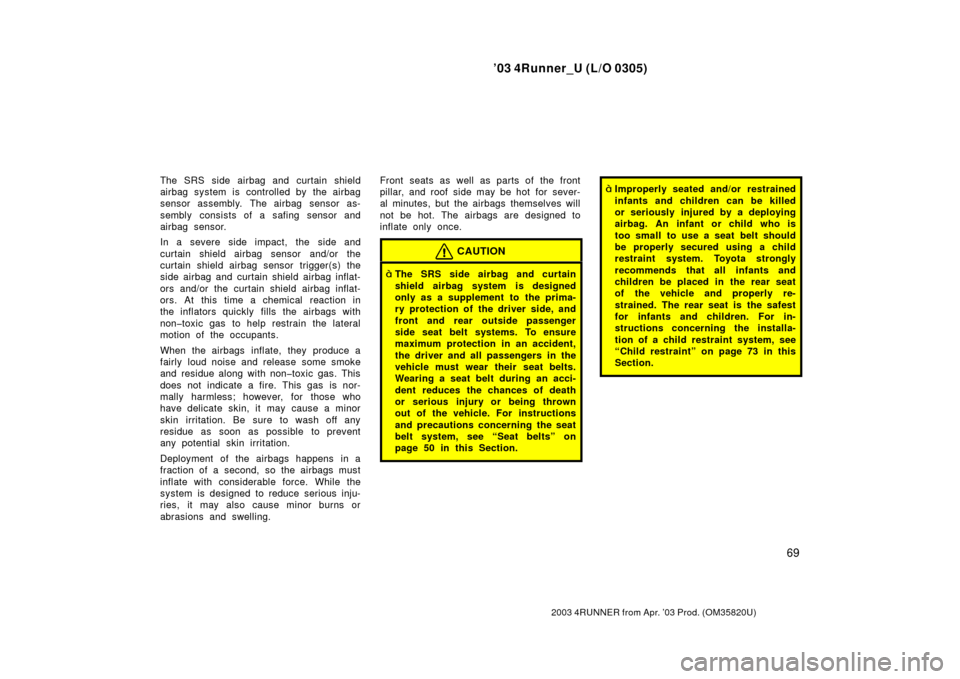
’03 4Runner_U (L/O 0305)
69
2003 4RUNNER from Apr. ’03 Prod. (OM 35820U)
The SRS side airbag and curtain shield
airbag system is controlled by the airbag
sensor assembly. The airbag sensor as-
sembly consists of a safing sensor and
airbag sensor.
In a severe side impact, the side and
curtain shield airbag sensor and/or the
curtain shield airbag sensor trigger(s) the
side airbag and curtain shield airbag inflat-
ors and/or the curtain shield airbag inflat-
ors. At this time a chemical reaction in
the inflators quickly fills the air bags with
non�toxic gas to help restrain the lateral
motion of the occupants.
When the airbags inflate, they produce a
fairly loud noise and release some smoke
and residue along with non�toxic gas. This
does not indicate a fire. This gas is nor-
mally harmless; however, for those who
have delicate skin, it may cause a minor
skin irritation. Be sure to wash off any
residue as soon as possible to prevent
any potential skin irritation.
Deployment of the airbags happens in a
fraction of a second, so the airbags must
inflate with considerable force. While the
system is desi gned to reduce serious inju-
ries, it may also cause minor burns or
abrasions and swelling. Front seats as well as parts of the front
pillar, and roof side may be hot for sever-
al minutes, but the airbags themselves will
not be hot. The airbags are designed to
inflate only once.
CAUTION
�The SRS side airbag and curtain
shield airbag system is designed
only as a supplement to the prima-
ry protection of the driver side, and
front and rear outside passenger
side seat belt systems. To ensure
maximum protection in an accident,
the driver and all passengers in the
vehicle must wear their seat belts.
Wearing a seat belt during an acci-
dent reduces the chances of death
or serious injury or being thrown
out of the vehicle. For instructions
and precautions concerning the seat
belt system, see “Seat belts” on
page 50 in this Section.
�Improperly seated and/or restrained
infants and children can be killed
or seriously injured by a deploying
airbag. An infant or child who is
too small to use a seat belt should
be properly secured using a child
restraint system. Toyota strongly
recommends that all infants and
children be placed in the rear seat
of the vehicle and properly re-
strained. The rear seat is the safest
for infants and children. For in-
structions concerning the installa-
tion of a child restraint system, see
“Child restraint” on page 73 in this
Section.
Page 76 of 373

’03 4Runner_U (L/O 0305)
70
2003 4RUNNER from Apr. ’03 Prod. (OM 35820U)
�Do not allow a child to lean his/her
head or any part of his/her body
against the front door or the area
of the seat, front pillar or roof side
from which the side airbag and cur-
tain shield airbag deploy even if he/
she is seated in the child restraint
system. It is dangerous if the side
airbag and curtain shield airbag in-
flate, and the impact could cause
death or serious injury to the child.
For instructions concerning the
installation of a child restraint sys-
tem, see “Child restraint” on page
73 in this Section.
�Do not lean against the door when
the vehicle is in use, since the side
airbag and curtain shield airbag in-
flate with considerable speed and
force. Otherwise, you may be killed
or seriously injured. Special care
should be taken especially when
you have a small child in the ve-
hicle.
�Sit up straight and well back in the
seat, distributing your weight evenly
in the seat. Do not apply excessive
weight to the outer side of the front
seats with a side airbag, and to the
front pillar, rear pillar and roof side
rail with a curtain shield airbag.
�Do not get your head closer to the
area where the side airbag and cur-
tain shield airbag inflate, since
these airbags inflate with consider-
able speed and force. Otherwise,
you may be killed or seriously in-
jured. Special care should be taken
especially when you have a small
child in the vehicle.
Page 79 of 373
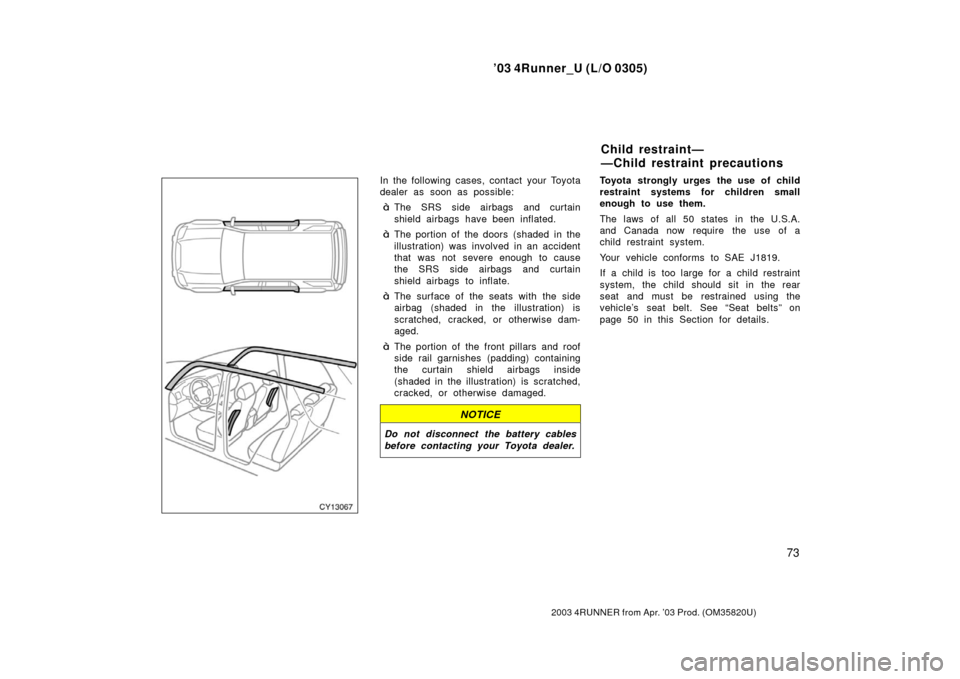
’03 4Runner_U (L/O 0305)
73
2003 4RUNNER from Apr. ’03 Prod. (OM 35820U)
In the following cases, contact your Toyota
dealer as soon as possible:
�The SRS side airbags and curtain
shield airbags have been inflated.
�The portion of the doors (shaded in the
illustration) was involved in an acci dent
that was not severe enough to cause
the SRS side airbags and curtain
shield airbags to inflate.
�The surface of the seats with the side
airbag (shaded in the illustration) is
scratched, cracked, or otherwise dam-
aged.
�The portion of the front pillars and roof
side rail garnishes (padding) containing
the curtain shield airbags inside
(shaded in the illustration) is scratched,
cracked, or otherwise damaged.
NOTICE
Do not disconnect the battery cables
before contacting your Toyota dealer.
Toyota strongly urges the use of child
restraint systems for children small
enough to use them.
The laws of all 50 states in the U.S.A.
and Canada now require the use of a
child restraint system.
Your vehicle conforms to SAE J1819.
If a child is too large for a child restraint
system, the child s hould sit in the rear
seat and must be restrained using the
vehicle’s seat belt. See “Seat belts” on
page 50 in this Section for details.
Child restraint—
—Child restraint precautions
Page 82 of 373
’03 4Runner_U (L/O 0305)
76
2003 4RUNNER from Apr. ’03 Prod. (OM 35820U)
Child restraint systems are classified into
the following 3 types depending on the
child’s age and size.
(A) Infant seat
(B) Convertible seat
(C) Booster seat
Install the child restraint system following
the instructions provided by its manufac-
turer.
Your vehicle has anchor brackets for se-
curing the top strap of a child restraint
system.
For instructions about how to use the an-
chor bracket, see “—Using a top strap” on
page 86 in this Section.
The child restraint lower anchorages ap-
proved for your vehicle may also be used.
See “—Installation with child restraint low-
er anchorages” on page 88 in this Sec-
tion.
(A) Infant seat
(B) Convertible seat
(C) Booster seat
—Types of child restraint
system
Page 90 of 373
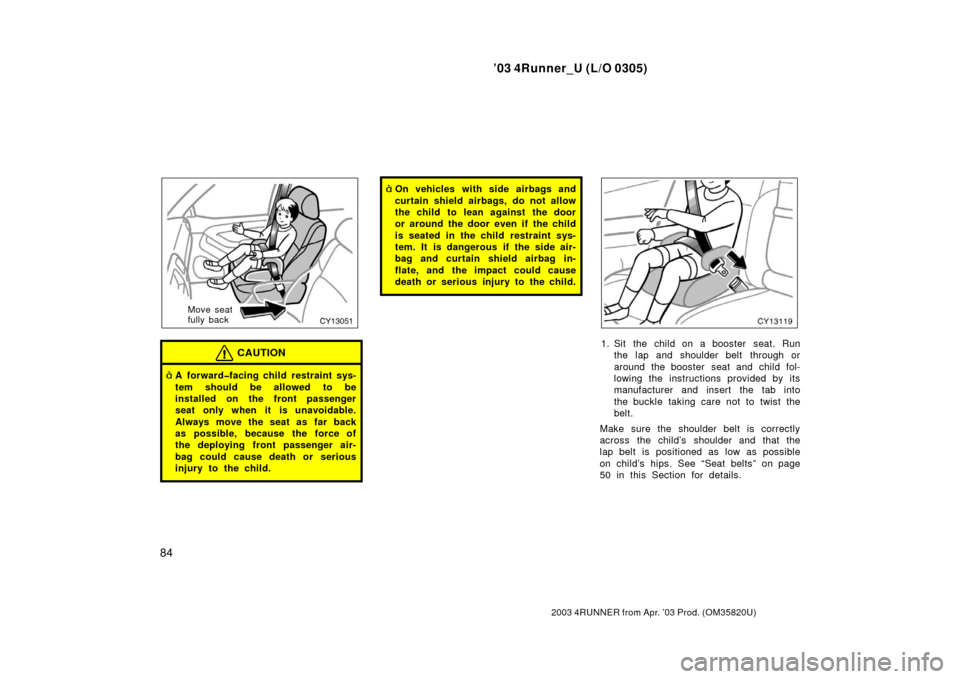
’03 4Runner_U (L/O 0305)
84
2003 4RUNNER from Apr. ’03 Prod. (OM 35820U)
Move seat
fully back
CAUTION
�A forward�facing child restraint sys-
tem should be allowed to be
installed on the front passenger
seat only when it is unavoidable.
Always move the seat as far back
as possible, because the force of
the deploying front passenger air-
bag could cause death or serious
injury to the child.
�On vehicles with side airbags and
curtain shield airbags, do not allow
the child to lean against the door
or around the door even if the child
is seated in the child restraint sys-
tem. It is dangerous if the side air-
bag and curtain shield airbag in-
flate, and the impact could cause
death or serious injury to the child.
1. Sit the child on a booster seat. Run
the lap and shoulder belt through or
around the booster seat and child fol-
lowing the instructions provided by its
manufacturer and insert the tab into
the buckle taking care not to twist the
belt.
Make sure the shoulder belt is correctly
across the child’s shoulder and that the
lap belt is positioned as low as possible
on child’s hips. See “Seat belts” on page
50 in this Section for details.
Page 93 of 373
’03 4Runner_U (L/O 0305)
87
2003 4RUNNER from Apr. ’03 Prod. (OM 35820U)
2. Raise the anchor bracket.3. Fix the child restraint system with
the seat belt.
Latch the hook onto the anchor
bracket and tighten the top strap.
For instructions to install the child re-
straint system, see “Child restraint” on
page 73 in this Section.
CAUTION
Make sure the top strap is securely
latched, and check that the child re-
straint system is secure by pushing
and pulling it in different directions.
Follow all the installation instructions
provided by its manufacturer.
4. Replace the head restraint.
Page 95 of 373
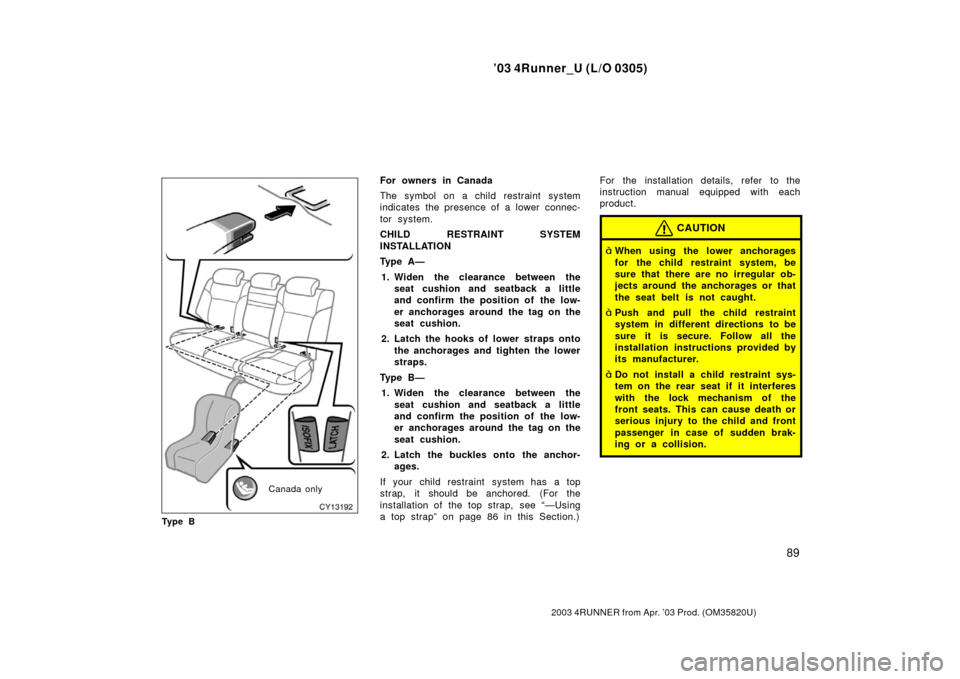
’03 4Runner_U (L/O 0305)
89
2003 4RUNNER from Apr. ’03 Prod. (OM 35820U)
Canada only
Ty p e B
For owners in Canada
The symbol on a child restraint system
indicates the presence of a lower connec-
tor system.
CHILD RESTRAINT SYSTEM
INSTALLATION
Ty p e A — 1. Widen the clearance between the seat cushion and seatback a little
and confirm the position of the low-
er anchorages around the tag on the
seat cushion.
2. Latch the hooks of lower straps onto the anchorages and tighten the lower
straps.
Ty p e B — 1. Widen the clearance between the seat cushion and seatback a little
and confirm the position of the low-
er anchorages around the tag on the
seat cushion.
2. Latch the buckles onto the anchor- ages.
If your child restraint system has a top
strap, it should be anchored. (For the
installation of the top strap, see “—Using
a top strap” on page 86 in this Section.) For the installation details, refer to the
instruction manual equipped with each
product.
CAUTION
�When using the lower anchorages
for the child restraint system, be
sure that there are no irregular ob-
jects around the anchorages or that
the seat belt is not caught.
�Push and pull the child restraint
system in different directions to be
sure it is secure. Follow all the
installation instructions provided by
its manufacturer.
�Do not install a child restraint sys-
tem on the rear seat if it interferes
with the lock mechanism of the
front seats. This can cause death or
serious injury to the child and front
passenger in case of sudden brak-
ing or a collision.
Page 97 of 373
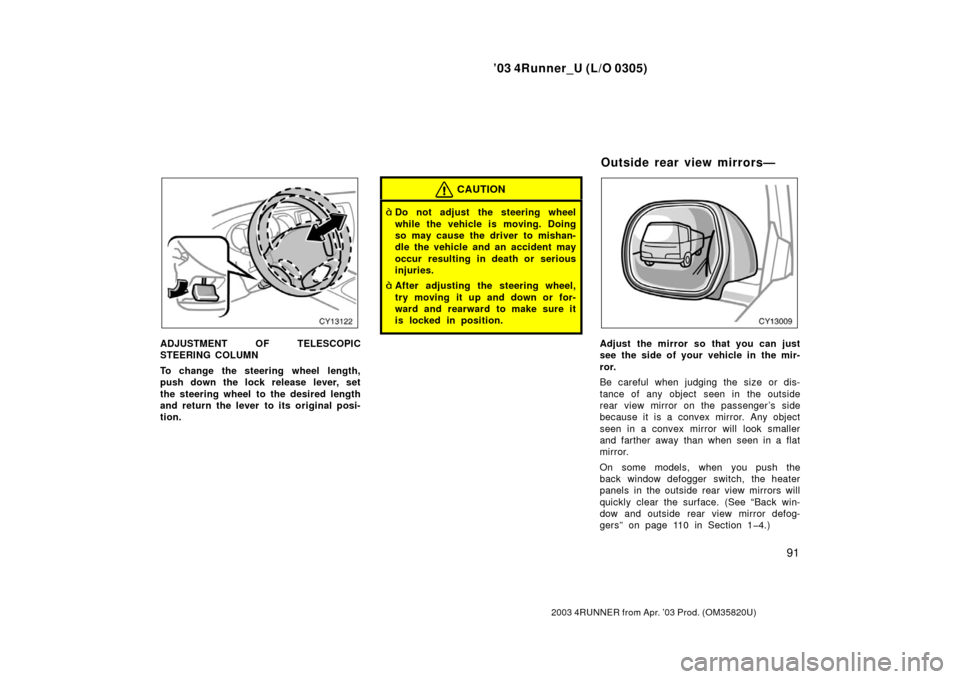
’03 4Runner_U (L/O 0305)
91
2003 4RUNNER from Apr. ’03 Prod. (OM 35820U)
ADJUSTMENT OF TELESCOPIC
STEERING COLUMN
To change the steering wheel length,
push down the lock release lever, set
the steering wheel to the desired length
and return the lever to its original posi-
tion.
CAUTION
�Do not adjust the steering wheel
while the vehicle is moving. Doing
so may cause the driver to mishan-
dle the vehicle and an accident may
occur resulting in death or serious
injuries.
�After adjusting the steering wheel,
try moving it up and down or for-
ward and rearward to make sure it
is locked in position.
Adjust the mirror so that you can just
see the side of your vehicle in the mir-
ror.
Be careful when judging the size or dis-
tance of any object seen in the outside
rear view mirror on the passenger ’s side
because it is a convex mirror. Any object
seen in a convex mirror will look smaller
and farther away than when seen in a flat
mirror.
On some models, when you push the
back window defogger switch, the heater
panels in the outside rear view mirrors will
quickly clear the surface. (See “Back win-
dow and outside rear view mirror defog-
gers” on page 110 in Section 1�4.)
Outside rear view mirrors—